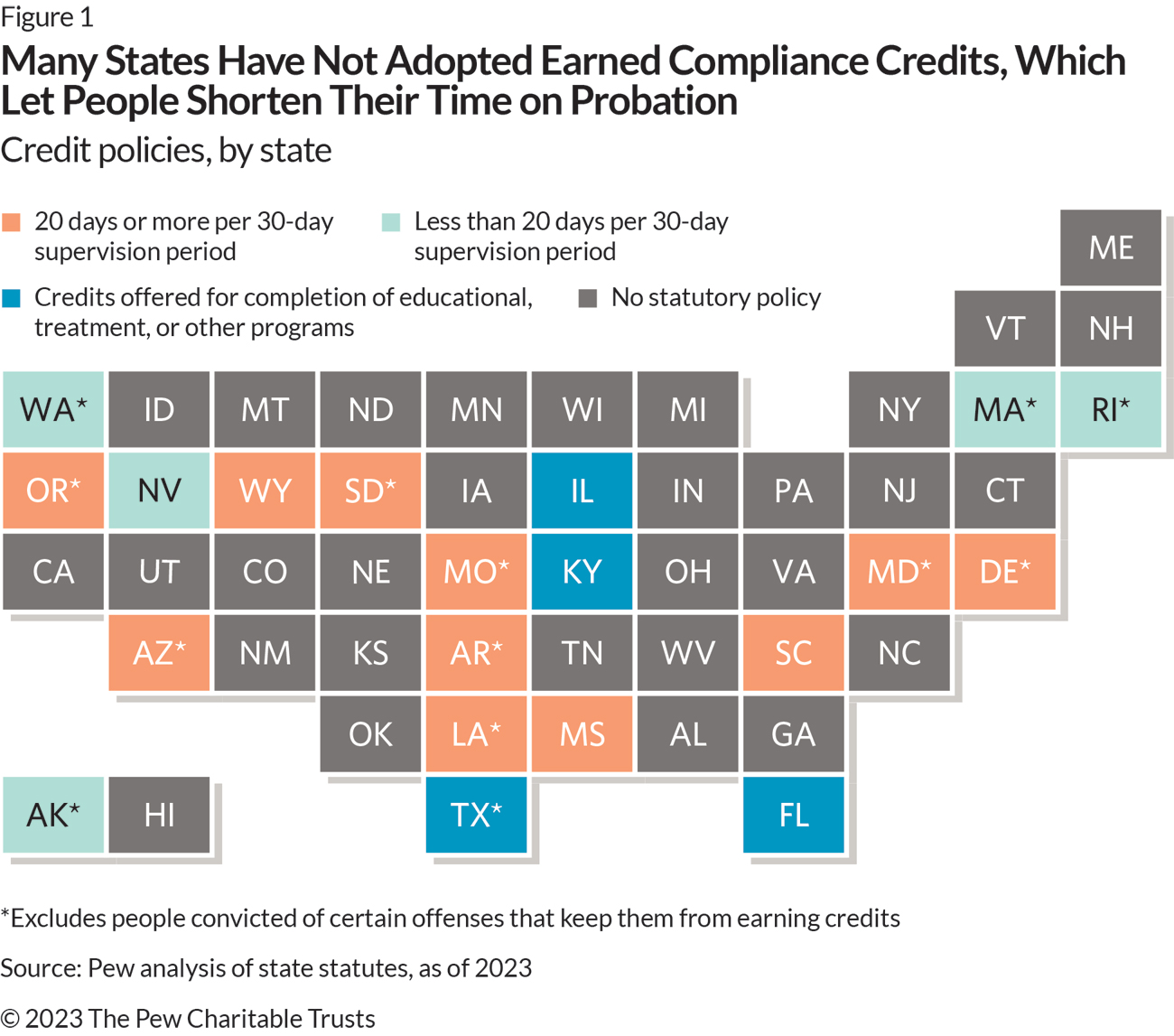Incentives Can Improve Probation Success
Behavioral science suggests that incentives can lead to better outcomes for people on probation

Overview
Probation, a form of correctional supervision imposed by a judge and served in the community in lieu of jail or prison, is often framed as a less punitive and more cost-effective alternative to incarceration.1 Since its inception in mid-19th-century America, probation has taken a myriad of forms and served many purposes, but one objective has remained consistent: to change behavior.2
Probation systems seek to promote certain behaviors (such as maintaining employment and participating in counseling) while discouraging others (for example, misusing substances or carrying weapons).3 People on probation must do more than simply abstain from criminal conduct; they must actively participate in many standard activities. For instance, people on probation are typically required to report to their probation officer on a regular basis, attend behavioral health treatment, and pay fees.4 At the outset of a sentence, each person on probation receives a list of rules and requirements delineating which activities are required and which are restricted, commonly referred to as supervision conditions. As long as a person complies with those conditions, they are normally allowed to remain in the community for the duration of their sentence.
But what is the most effective way to encourage people on probation to comply with their supervision conditions?
For decades, U.S. probation systems have relied on punishment—or the threat of punishment—to enforce supervision conditions and deter noncompliance.5 Probation punishments may include increased monitoring, additional requirements, or even incarceration.6 Reliance on punishment stands in stark contrast to decades of behavioral science research, which teaches that incentives—tools to encourage a desired goal or activity—are equally as, if not more, effective than punishments in bringing about behavioral change.
Yet, limited probation budgets and large caseloads can make catching and punishing rule violations—including revoking probation—seem easier for probation officers to manage than proactively incentivizing compliance among people under supervision.7 As a result, arrests for probation rule violations have become a meaningful contributor to incarceration, accounting for approximately 1 in 10 of all new prison admissions.8 And, while virtually all probation systems have processes for punishing people if they fail to meet their supervision conditions, few systems have corresponding incentive policies to encourage continued participation or recognize when people succeed.
The paucity of incentive policies in U.S. probation systems is not for lack of options. Over the past couple of decades, innovative probation officials, scholars, and legislators throughout the country have experimented with and recommended several types of probation incentives. Some of the most common forms include verbal recognition, gift cards, reduced supervision conditions or monitoring, and early discharge from supervision.9 All of these incentives can support behavior change, and several have the added potential, when used effectively, of decreasing probation populations and officer caseloads, reining in correctional spending, and focusing probation resources on higher-risk individuals.
Unfortunately, research about the best ways to use incentives in community supervision settings is limited—one of the publications most frequently cited in articles on probation incentives is more than 12 years old, and the data it uses is more than 20 years old.10 However, behavioral scientists have spent decades conducting experiments to determine what makes incentives—and consequences—most effective generally.
An effective incentive system will likely have the following attributes:
- Value: Incentives should be highly valued by the people receiving them. Although people on probation typically find early discharge from supervision to be the most valuable incentive, the value of a particular incentive depends on individual factors, such as socioeconomic status or parenthood, and on whether a recipient deems an incentive proportionate to the triggering behavior.11
- Frequency:Research suggests that incentives should be delivered at least four times more often than punishments.12
- Swiftness: Criminal justice literature often underscores the fact that a punishment or incentive administered too long after the behavior it is intended to dissuade may not have the desired effect, because the person subject to the punishment or incentive may not connect the behavior to the consequence well enough for the punishment to have a lasting effect.13
- Consistency: As with swiftness, incentives offered too inconsistently may not have the desired effect of a person considering the experience of a positive reward the next time they must decide whether to engage in a desirable behavior.14 When recipients are certain that they will benefit from a behavior, it is more likely that they will sustain it.
What types of incentives are most likely to be effective in probation?
Incentives should be valued by people on probation
Perhaps not surprisingly, the more a person values a given incentive, the more likely it is to affect their behavior.15 Multiple studies have found that people on probation place the highest premium on early discharge, with the more time a person can earn off their term, the more valuable the incentive—which supports the case for early discharge policies.16
Common Types of Probation Incentives
- Early discharge from supervision.
- Relaxed monitoring.
- Gift cards.
- Words of praise.
- Additional liberties (such as curfew extensions or permission to travel out of state).17
Value, however, does not exist in a vacuum: To be effective, an incentive must be proportionate to the action it’s meant to inspire, with the value of a particular incentive depending on what type of behavior it’s attached to.18 For instance, if a person is in a dire financial situation, the perceived value of a $10 gift card may increase; if a person has only a week left on probation, an early discharge may not significantly affect their decision-making.19
Incentives should be delivered with frequency, swiftness, and consistency
Incentives that are delivered often, consistently, and shortly after a desirable action can influence behavior and shape long-term habits.20 The aforementioned seminal 2011 study on the use of incentives in probation suggests that incentives should be doled out at least four times as often as sanctions.21 Despite the age of the study, the important takeaway is clear: Incentives are most effective when they are delivered more frequently than sanctions.22
Additionally, the quicker a person experiences a benefit following an action, the more likely it is that they will begin to associate a desirable outcome with the triggering behavior—thus reinforcing the behavior.23 Typically, the further into the future a reward is expected, the less valuable it becomes.24 This is why, for instance, regular exercise may be hard to sustain for many individuals—the reward of a healthier body would occur sometime in the distant future.
Research shows that people who have been convicted of criminal charges tend to have an exaggerated disregard for incentives that are expected down the line.25 Large gains expected in the future often mean even less to a person convicted of a crime than to someone who has never faced criminal charges.
Certainty and consistency can also enhance the relationship between an incentive and a desired behavior. The research shows that consistency is crucial for precision and predictability when attempting to reinforce a new behavior.26 When a person is uncertain about what benefits will come from a particular behavior, it changes how much weight they give the potential incentive in their decision-making and may slow down the habit forming process.
Policy example: earned compliance credits
Among the most highly valued incentives are earned compliance credits, which allow people to earn time off probation by complying with supervision conditions.27
As of May 2023, 20 states offered earned compliance credits by statute (see Appendix for full list). The most common form allows people to reduce their time on probation at a designated rate for every month of compliance, although the number of days a person can earn per month varies from state to state.
Four states attach credits to particular achievements. For instance, in Texas, someone on probation can earn 60 days of credits for completing a vocational training course.28
There’s still much to learn about the impact of earned compliance credits in each of the 20 states that offer them. However, research suggests that the probation systems delivering highly proportionate ratios of credits with consistency have had promising results.
The Success of Earned Compliance Credits in Missouri
The Urban Institute evaluated Missouri’s earned compliance credit policy from its implementation in 2012 until 2018, comparing recidivism rates for people who received early discharge through earned compliance credits with those discharged from supervision before the state had implemented the policy. The report found no increase in recidivism for people who earned early discharges.29Furthermore, in the six years following the policy’s implementation, Missouri’s supervision populations (both probation and parole) declined by 30%—and the terms of those who received earned compliance credits and successfully completed supervision were cut on average by more than a year.30
The Success of Earned Compliance Credits in Arizona
Arizona implemented earned compliance credits in 2008 as part of broader probation reforms that also included prioritizing resources for people with high levels of risk and need.31 By 2022, the rate at which people were taken off probation and sent to prison had dropped 56.5%, saving the state more than $400 million on corrections spending, and new felony convictions for people on probation dropped 6.7%.32 Although it’s not possible to parse out the exact impact of earned compliance credits from other reforms included in the 2008 reform package, the credits likely contributed to these positive trends.33
Conclusion
Since its inception, probation has sought to affect the way that people on supervision behave—but not typically by using incentives, a crucial tool for changing behaviors. Yet, probation systems across the country have begun to employ them, albeit slowly, as a central strategy for promoting compliance and long-term behavior change among people under supervision.
People on probation constitute the largest of all correctional populations, yet often the fewest resources and services are devoted to promoting successful outcomes for them. Of all the branches of our criminal justice system, probation systems may be most in need of the benefits that effective incentives can offer: a reduction in population sizes, increased compliance and successful outcomes, and the capacity for officers to focus more attention on the high-risk individuals who may need more services.
Policymakers seeking to develop a robust incentives policy should look to the components derived from nearly a century of behavioral science to ensure that incentives are:
- Highly valuable to the recipient.
- Proportionate to the triggering action.
- Delivered with swiftness, frequency, and consistency.
Appendix:
Methodology
The data used in this brief related to earned compliance credits is from state statutes as of May 2023 that address earned credits. All statutes were verified by officials within the state probation agency or administrative office of the courts and, in some instances, both. The compliance credit data represents an updated version of Pew’s original earned compliance credit statutory review in its 2022 report “Five Evidence-Based Policies Can Improve Community Supervision.”
This brief uses earned compliance credits to illustrate the concepts discussed above and general trends in the use of probation incentives. Earned compliance credits were selected as the policy example partially because the policy offers one of the highest-value incentives, but also because compliance credit policies are almost always enshrined in state statute. Incentives that may require fewer resources and may be easier to implement, such as formal written or verbal recognition, may not be as conducive to a 50-state comparative analysis.
Furthermore, even among earned compliance policies, this analysis does not evaluate the impact of particular statutes, only the structure of the written policy. A variety of factors influence whether laws are implemented with fidelity and how substantial or limited their impact may be. The criteria for evaluating a state’s statutes are based on available evidence and do not consider policy implementation, political dynamics, or regional and jurisdictional differences. Additionally, many probation systems operate on a county or regional level rather than state level, and this analysis cannot—and does not attempt to—fully evaluate these and other jurisdictional nuances. Consequently, the analysis may not fully reflect the lived experiences of people under supervision, or the state’s policy as implemented, and stakeholders in a given state may be better positioned to explore these factors in depth.
States that offer earned compliance credits usually offer 20 or 30 credit days per 30 days of compliance. This brief establishes the following breakpoints based on states’ current practices:
- 20 days or more of credits per 30-day supervision period (11 states).
- Less than 20 days per 30-day supervision period (five states).
- Provision of earned credits based on completing a program, such as substance misuse treatment, life skills, or high school equivalency, rather than for general compliance. These credits are not necessarily associated with how long it may take to complete the program and are awarded only upon completion (four states).
- No statutory policy (20 states).
Additional data was pulled from a literature review of existing research related to the use of incentives in community supervision systems and behavioral science research about the utility of incentives as a mechanism for behavior modification.
Table of Statutes
| State | Statue |
|---|---|
| AL | No applicable statute |
| AK | Alaska Stat. § 33.05.020 |
| AZ | A.R.S. §13-924 |
| AR | A.C.A. §16-90-1301-1304 |
| CA | No applicable statute |
| CO | No applicable statute |
| CT | No applicable statute |
| DE | 11 Del. C. §4383 |
| FL | Fla. Stat. § 948.05 |
| GA | No applicable statute |
| HI | No applicable statute |
| ID | No applicable statute |
| IL | §730 ILCS 5/5-6-2 |
| IN | No applicable statute |
| IA | No applicable statute |
| KS | No applicable statute |
| KY | KRS §439.268 |
| LA | La. Code Crim. Proc. Art. 895.6 |
| ME | No applicable statute |
| MD | Md. Code Correctional Services Ann. §6-117 |
| MA | ALM GL ch. 276, §87B |
| MI | No applicable statute |
| MN | No applicable statute |
| MS | Miss. Code Ann. §47-7-40 |
| MO | § 217.703 R.S.Mo |
| MT | No applicable statute |
| NE | No applicable statute |
| NV | Nev. Rev. Stat. §176A.500 |
| NH | No applicable statute |
| NJ | No applicable statute |
| NM | No applicable statute |
| NY | No applicable statute |
| NC | No applicable statue |
| ND | No applicable statue |
| OH | No applicable statue |
| OK | No applicable statue |
| OR | ORS §137.633 |
| PA | No applicable statue |
| RI | RI Gen. Laws §42-56-24 |
| SC | SC Code §24-21- 280 |
| SD | SD Codified Law §23A-48-19; §16- 22-19 |
| TN | No applicable statute |
| TX | Tex. Code Crim. Proc. Art. 42A.702 |
| UT | No applicable statute |
| VT | No applicable statute |
| WA | RCW §9.94a.717 |
| WV | No applicable statute |
| WI | No applicable statute |
| WY | Wyo. Stat. §7-16-104 |
Endnotes
- C. Klingele, “Rethinking the Use of Community Supervision,” Journal of Criminal Law & Criminology 103, no. 4 (2013): 1015-69, https://papers.ssrn.com/sol3/papers.cfmabstract_id=2232078#.
- Ibid.; J. Petersilia, “Employ Behavioral Contracting for ‘Earned Discharge’ Parole,” Criminology & Public Policy 6, no. 4 (2007): 807-14, https://onlinelibrary.wiley.com/doi/abs/10.1111/j.1745-9133.2007.00472.x.
- Klingele, “Rethinking the Use of Community Supervision.”
- Ibid.; The Pew Charitable Trusts, “For People Under Probation, Conditions Meant to Support Behavior Change Can Burden More Than Benefit,” March 14, 2023, https://www.pewtrusts.org/en/research-and-analysis/issue-briefs/2023/03/for-people-under-probationconditions- meant-to-support-behavior-change-can-burden-more-than-benefit; J.M. Harcum, “Terminating Guardianships and Returning Children to Parents: Pitfalls and Possibilities,” Illinois Bar Journal 95, no. 10, https://www.isba.org/ibj/2007/10.
- H. Gore and I. Shapiro, “Incentives for Those on Probation Can Improve Outcomes and Rein in Costs,” The Pew Charitable Trusts, accessed July 12, 2023, https://www.pewtrusts.org/en/research-and-analysis/articles/2023/02/07/incentives-for-those-on-probationcan-improve-outcomes-and-rein-in-costs.
- Klingele, “Rethinking the Use of Community Supervision.”
- The Pew Center on the States, “One in 31: The Long Reach of American Corrections” (The Pew Charitable Trusts, 2009), https://www.pewtrusts.org/-/media/assets/2009/03/02/pspp_1in31_report_final_web_32609.pdf; M.P. Jacobson et al., “Less Is More: How Reducing Probation Populations Can Improve Outcomes” (Harvard Kennedy School, 2017), https://www.hks.harvard.edu/centers/wiener/programs/criminaljustice/research-publications/executive-session-on-communitycorrections/publications/less-is-more-howreducing-probation-populations-can-improve-outcomes.
- Council of State Governments, “Confined and Costly: How Supervision Violations Are Filling Prisons and Burdening Budgets” (2019), https://csgjusticecenter.org/publications/confined-costly/.
- American Probation and Parole Association, National Center for State Courts, and The Pew Charitable Trusts, “Effective Responses to Offender Behavior: Lessons Learned for Probation and Parole Supervision” (2013), https://nicic.gov/resources/nic-library/all-libraryitems/effective-responses-offender-behavior-lessons-learned.
- E.J. Wodahl et al., “Utilizing Behavioral Interventions to Improve Supervision Outcomes in Community-Based Corrections,” Criminal Justice and Behavior 38, no. 4 (2011): 386-405, https://journals.sagepub.com/doi/abs/10.1177/0093854810397866.
- E.J. Wodahl, B.E. Garland, and T.J. Mowen, “Understanding the Perceived Value of Incentives in Community Supervision,” Corrections 2, no.3 (2017): 165-88, https://doi.org/10.1080/23774657.2017.1291314.
- Wodahl et al., “Utilizing Behavioral Interventions.”
- American Probation and Parole Association, National Center for State Courts, and The Pew Charitable Trusts, “Effective Responses to Offender Behavior.”
- B.F. Skinner, “Operant Behavior,” in Operant Behavior: Areas of Research and Application, ed. W.K. Honig (New York, NY: Appleton-Century- Crofts, 1966); E.W. Swaim, “B.F. Skinner and Carl R. Rogers on Behavior and Education,” Oregon ASCD Curriculum Bulletin 28, no. 324 (1974), https://eric.ed.gov/?id=ED098087; American Probation and Parole Association, National Center for State Courts,and The Pew Charitable Trusts, “Effective Responses to Offender Behavior.”
- J.M. Elbers et al., “The Effects of Reward Systems in Prison: A Systematic Review,” International Journal of Law, Crime and Justice 71 (2022), https://doi.org/10.1016/j.ijlcj.2022.100556.
- Wodahl, Garland, and Mowen, “Understanding the Perceived Value of Incentives.”
- American Probation and Parole Association, National Center for State Courts, and The Pew Charitable Trusts, “Effective Responses to Offender Behavior.”
- Wodahl, Garland, and Mowen, “Understanding the Perceived Value of Incentives.” American Probation and Parole Association, National Center for State Courts, and The Pew Charitable Trusts, “Effective Responses to Offender Behavior.”
- Wodahl, Garland, and Mowen, “Understanding the Perceived Value of Incentives.”
- J.E. Staddon and D.T. Cerutti, “Operant Conditioning,” Annu Rev Psychol 54 (2003): 115-44, https://www.ncbi.nlm.nih.gov/pubmed/12415075.
- Wodahl et al., “Utilizing Behavioral Interventions.”
- Ibid.
- Swaim, “B.F. Skinner and Carl R. Rogers on Behavior and Education.”
- J. Broughel, “The Social Discount Rate: A Primer for Policymakers” (George Mason University Mercatus Center, 2020), https://www.mercatus.org/research/policy-briefs/social-discount-rate-primer-policymakers; B.C. Prest, W. Pizer, and R.G. Newell, “ImprovingDiscounting in the Social Cost of Carbon,” Resources (blog), https://www.resources.org/archives/improving-discounting-in-the-socialcost-of-carbon/.
- J. Arantes et al., “Offenders Have Higher Delay-Discounting Rates Than Non-Offenders After Controlling for Differences in Drug and Alcohol Abuse,” Legal and Criminological Psychology 18 (2013): 240-53, DOI:10.1111/j.2044-8333.2012.02052.x.
- Swaim, “B.F. Skinner and Carl R. Rogers on Behavior and Education.”
- Gore and Shapiro, “Incentives for Those on Probation.”
- Texas Code Crim. Proc. Art. 42a.702 (2021).
- The Pew Charitable Trusts, “Missouri Policy Shortens Probation and Parole Terms, Protects Public Safety” (2016), https://www.pewtrusts.org/en/research-and-analysis/issue-briefs/2016/08/missouri-policy-shortens-probation-and-parole-terms-protects-public-safety.
- R. Olsen et al., “An Assessment of Earned Discharge Community Supervision Policies in Oregon and Missouri” (Urban Institute, 2022),https://www.urban.org/sites/default/files/publication/105347/an-assessment-of-earned-discharge-community-supervision-policies-inoregon-and-missouri.pdf; The Pew Charitable Trusts, “Missouri Policy Shortens Probation and Parole Terms.”
- State of Arizona Supreme Court, “Safe Communities Report” (2022), https://www.azcourts.gov/Portals/25/SafeCommunitiesAct/FY%202022%20Safe%20Communities%20Report%20Final.pdf?ver=taFR915wWg47VKvJX24AvQ%3d%3d.
- M. Nevarez, FY 2022 Adult Probation Fact Sheet (2022), https://www.azcourts.gov/Portals/25/Facts%20Sheet/FY%202022%20APSD%20Fact%20Sheet.pdf; State of Arizona Supreme Court, ”Safe Communities Report.”
- Alliance for Safety and Justice, “Employment Credits for People on Probation Promote Economy and Public Safety” (2023), https://allianceforsafetyandjustice.org/wp-content/uploads/2023/02/ASJ-Report-Incentives-Work-January-2023.pdf.











